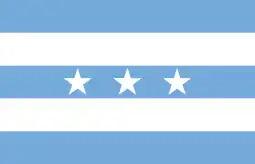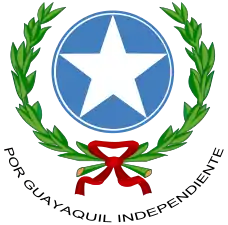Guayaquil
Santiago de Guayaquil | |
|---|---|
| Santiago of Guayaquil | |
 Top left: Lighthouse on Santa Ana Hill. Top upper right: Malecón Simón Bolívar (downtown area) from Santa Ana Hill. Top lower right: Guayaquil Metropolitan Cathedral. Middle left: Guayaquil City Office. Middle right: Ninth of October Avenue (Avenida Nueve de Octubre) seen from Malecón 2000. Bottom left: El Carmen Hills. Bottom right: Guayas River and Guayaquil National Unity Bridge (Puente Unidad Nacional). | |
| Nickname(s): La Perla del Pacífico English: The Pearl of the Pacific | |
| Motto(s): Por Guayaquil Independiente English: For Independent Guayaquil | |
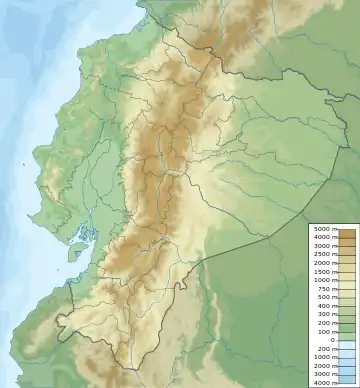 Guayaquil 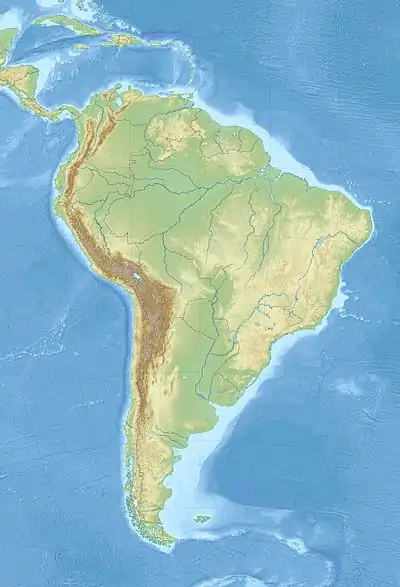 Guayaquil | |
| Coordinates: 02°11′24″S 79°53′15″W / 2.19000°S 79.88750°W | |
| Country | |
| Province | Guayas |
| Canton | Guayaquil |
| Spanish foundation | 25 July 1535 |
| Independence | 9 October 1820 |
| Founded by | Francisco de Orellana |
| Named for | Guayas and Quil |
| Urban parishes | 16 urban parishes |
| Government | |
| • Type | Mayor and council |
| • Governing body | Municipality of Guayaquil |
| • Mayor | Aquiles Álvarez |
| • Vice-Mayor | Blanca López |
| Area | |
| • City | 344.5 km2 (133.01 sq mi) |
| • Land | 316.42 km2 (122.17 sq mi) |
| • Water | 28.08 km2 (10.84 sq mi) |
| • Metro | 2,493.86 km2 (962.88 sq mi) |
| Elevation | 4 m (13.2 ft) |
| Population (2022) | |
| • City | 2,650,288[1] |
| • Metro | 3,618,450 |
| Demonym | Guayaquileño |
| GDP (PPP, constant 2015 values) | |
| • Year | 2023 |
| • Total | $42.9 billion[2] |
| Time zone | UTC−5 (ECT) |
| Postal code | EC090150 |
| Area code | (0)4 |
| Vehicle registration | G |
| Languages | Spanish |
| Climate | Aw |
| Website | Municipality of Guayaquil |
Guayaquil (Spanish pronunciation: [ɡwaʝaˈkil] ⓘ; Quechua: Wayakil), officially Santiago de Guayaquil, is the largest city in Ecuador and also the nation's economic capital and main port. The city is the capital of Guayas Province and the seat of Guayaquil Canton. The city is located on the west bank of the Guayas River, which flows into the Pacific Ocean at the Gulf of Guayaquil.
Name
The origin of the name of the city of Santiago de Guayaquil has been much discussed, although historians agree that it is pre-Hispanic. Since the founding of the city in 1534, it is linked to the name of Santiago in memory of its patron saint, Santiago, apostle of Christ, who is also patron saint of several other Spanish American colonial cities, such as Santiago de Chile, as he is of Spain itself.[3]
One of the theories, based on a romantic legend, transmitted orally from one generation to another, attributes the origin of the name Guayaquil to the joining of the name of a leader named Guayas and of his wife Quil, symbols of the local resistance that—according to local tradition—chose to fight to the death (and as a final act, set fire to the town), rather than surrender to the Spanish conquerors.[4]
The existence of a town with a name similar to Guayaquil, located near the city of Durán (Autopista Durán-Boliche km. 23), has brought investigations by archeologists and historians, who agree that the town, when it was conquered, was ruled by a man named Guayaquile.[5] What was not decided was whether the name was given by the man to the town, or the town to the man. But the researcher Ángel Véliz Mendoza, in his book on the man Guayaquile, states that there are at least seven references to the toponym in pre-1543 documents.[6] It is believed that the name Guayaquil is taken from the population's final home, in lands of the chief Guayaquile. This region was occupied by the "chonos" people whose archeological name is es:cultura Milagro-Quevedo.[5]
After several location changes and fires, the city was finally founded in 1547, and named the "Muy Noble y Muy Leal Ciudad de Santiago de Guayaquil" ("Very noble and very loyal city of Santiago de Guayaquil"). After the city's independence in 1820, the words "very noble and very loyal" disappeared as the city was no longer part of the Spanish Empire. Today, the official name of Santiago de Guayaquil is seldom used outside of official contexts.
History
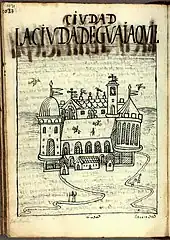

Guayaquil was founded on 25 July 1538[8] by Spanish conqueror Francisco de Orellana in the location of a native village and given the name Muy Noble y Muy Leal Ciudad de Santiago de Guayaquil ("Most Noble and Most Loyal City of Santiago de Guayaquil").[9]
On 20 April 1687, Guayaquil was attacked and looted by English and French pirates under the command of George d'Hout (English) and Picard and Groniet (French).[10] Of more than 260 pirates, 35 were killed and 46 were wounded; 75 defenders of the city died and more than 100 were wounded.
In 1709, English captains including Woodes Rogers and William Dampier, along with a crew of 110, looted Guayaquil and demanded ransom; however, they departed suddenly and without collecting the ransom after an epidemic of yellow fever broke out.
In colonial times Guayaquil was the chief Spanish shipyard in the Pacific, although some navigators considered that Valdivia (now in Chile) had better conditions.[11][12]
Guayaquil was a stopover point in the commerce between Asia and Latin America conducted by Philippines-based Manila galleons, which had links to Acapulco in Mexico and terminated with a node in Callao, Peru.[13]
In the late eighteenth century, the majority of slaves in the region were located in Guayaquil, where their life and work were conditioned by a practice called jornal. The owners were in charge but the jornalado slaves had "considerable independence"[14] in exchange for paying their owners a fee (the jornal) every day. Slaves like María Chiquinquirá, local hero because she successfully went to court in 1794 to argue her freedom, would work inside urban homes. Many slaves worked alongside free workers in the shipyards. By the turn of the nineteenth century, slaves had fought for their freedom in increasing numbers, and together formed a social group known as the plebe.[14]
On 9 October 1820, almost without bloodshed, a group of civilians, supported by soldiers from the "Granaderos de Reserva" battalion quartered in Guayaquil, led by the Peruvian Colonel Gregorio Escobedo, overwhelmed the resistance of the Royalist guards and arrested the Spanish authorities. Guayaquil declared independence from Spain, becoming the "Provincia Libre de Guayaquil", and José Joaquín de Olmedo was named Jefe Civil of Guayaquil.
Departing from Guayaquil, General Antonio José de Sucre, sent by Simón Bolivar and supported by a division promised by José de San Martín, led the allied independence army in the Battle of Pichincha that sealed the independence of the Gran Colombia and also what would become the future Republic of Ecuador.
On 26 July 1822, generals José de San Martín and Simón Bolívar held a meeting in Guayaquil to plan how to the complete the independence of Perú and with it all of Spanish South America. In 1829, the city was invaded by the Peruvian Army, which occupied it for seven months.
In 1860, the city was the site of the Battle of Guayaquil, the last of a series of military conflicts between the forces of the Provisional Government, led by Gabriel García Moreno and General Juan José Flores, and the forces of the Supreme Chief of Guayas, General Guillermo Franco, whose government was recognized as possessing sovereignty over the Ecuadorian territory by Peruvian president Ramón Castilla. Moreno's forces were victorious, countering Peruvian influence over Ecuador.
In 1896, large portions of the city were destroyed by a fire.[15]
On 8 July 1898, the Guayaquil City Hall Muy Ilustre Municipalidad de Guayaquil officially recognized the anthem written by José Joaquín de Olmedo in 1821, with the music composed by Ana Villamil Ycaza in 1895, as the Himno al 9 de Octubre or Canción al Nueve de Octubre, most widely known now as the Himno a Guayaquil (Guayaquil Anthem).
In 1922, workers in the city went on a general strike lasting three days, ending after at least 300 people were killed by military and police.
In 2020, the city was hit hard by the coronavirus pandemic. Its medical and mortuary services were overwhelmed to the point where bodies lay in the streets.[16] Almost 6,000 more deaths were recorded in the first two weeks of April than the average for the same period in other years.[17]
Economy
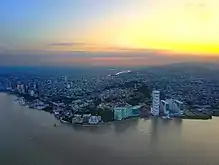
Guayaquileños' main sources of income are formal and informal trade, business, agriculture and aquaculture. Most commerce consists of small and medium businesses, adding an important informal economy occupation that gives thousands of guayaquileños employment.[18]
The Port of Guayaquil is Ecuador's most important commercial port; most international import and export merchandise passes through the Gulf of Guayaquil. As the largest city in the country,[19] most industries are located either in the city or its peripheral areas.
Government
As of 2020 Guayaquil's mayor was Cynthia Viteri, the second elected female mayor in the city's history, the first being Elsa Bucaram in 1988. The previous mayor, Jaime Nebot, endorsed her. A campaign of construction projects for the city began in the early 2000s to attract tourism. The "urban regeneration" plan reconstructed the city's main tourist streets' sidewalks and upgraded the city's chaotic transit system with multiple infrastructure projects (speedways, bridges, overhead passages, tunnels, etc.).[20]
In August 2006, the city's first rapid transit bus system, Metrovía, opened to provide a quicker, high-capacity service. One of the main projects was called Malecón 2000 [maleˈkon dos ˈmil], the renovation of the waterfront promenade (malecón) along the Guayas River. Another project was the creation of the Nuevo Parque Histórico, a park in a housing development area that is called Entre Ríos because it lies between the Daule and Babahoyo rivers (which merge to form the Guayas River) in a mangrove wetland area. The park cost the city about US$7 million.
In 2013, the national government led by Rafael Correa built two pedestrian bridges connecting downtown Guayaquil, Santay Island, and the town of Durán, to allow people to make ecotourism trips and return the same day.
Geography
Guayaquil is the nation's second largest city[21] and the capital of Guayas Province. It is on the Guayas River about 60 km (40 mi) north of the Gulf of Guayaquil, near the Equator.
Guayaquil faces major earthquake threats due to its soil stratigraphy and location on the ring of fire and the south of the North-Andean subduction zone.[22]
The city can be easily damaged by earthquakes as its weak and compressible soil is composed of deep soft sediments over hard rocks and deposits in a brackish environment. Also, the city itself is strongly affected by the subduction of the active Ecuadorian margin, an intraplate region where active faults locate; and the Guayaquil-Babahoyo strike-slip fault system, formed as the North Andean Block drifts northward.[23]
The tsunami threat is caused by the nearby Gulf of Guayaquil which also is one of the major locations on the Earth where earthquakes tend to happen all the time. It has complex tectonic features such as the Posorja and the Jambeli – two major east–west trending detachment systems; the Puna-Santa Clara northeast-southwest trending fault system; and the Domito north-south trending fault system; that have developed since the Pleistocene times. Tsunami threats are only predicted for coastal farming zones, not the main populated areas.[24][25]
Guayaquil, along with most of the coastal region, was impacted by the 16 April 2016 earthquake of 7.8 magnitude. A bridge that was above a major artery, Avenida de las Americas, collapsed in the early evening on that day, killing two people.
Climate
Guayaquil features a tropical savanna climate (Köppen: Aw). Between January and April, the climate is hot and humid with heavy rainfall, especially during El Niño years when it increases dramatically and flooding usually occurs. The rest of the year (from May through December), however, rainfall is minimal due to the cooling influence of the Humboldt Current, with usually cloudy mornings and afternoons, and evening breezes.
| Climate data for Guayaquil | |||||||||||||
|---|---|---|---|---|---|---|---|---|---|---|---|---|---|
| Month | Jan | Feb | Mar | Apr | May | Jun | Jul | Aug | Sep | Oct | Nov | Dec | Year |
| Record high °C (°F) | 37.2 (99.0) |
35.4 (95.7) |
37.3 (99.1) |
35.8 (96.4) |
35.2 (95.4) |
35.0 (95.0) |
34.1 (93.4) |
34.7 (94.5) |
34.4 (93.9) |
35.1 (95.2) |
35.4 (95.7) |
36.7 (98.1) |
37.3 (99.1) |
| Mean daily maximum °C (°F) | 31.2 (88.2) |
31.2 (88.2) |
32.2 (90.0) |
32.0 (89.6) |
31.2 (88.2) |
29.8 (85.6) |
29.1 (84.4) |
29.7 (85.5) |
30.5 (86.9) |
30.2 (86.4) |
31.1 (88.0) |
31.8 (89.2) |
30.8 (87.4) |
| Daily mean °C (°F) | 27.1 (80.8) |
27.3 (81.1) |
28.0 (82.4) |
27.8 (82.0) |
26.9 (80.4) |
25.7 (78.3) |
25.0 (77.0) |
25.2 (77.4) |
25.5 (77.9) |
25.6 (78.1) |
26.2 (79.2) |
27.1 (80.8) |
26.5 (79.7) |
| Mean daily minimum °C (°F) | 23.0 (73.4) |
23.4 (74.1) |
23.7 (74.7) |
23.5 (74.3) |
22.6 (72.7) |
21.5 (70.7) |
20.8 (69.4) |
20.7 (69.3) |
20.5 (68.9) |
20.9 (69.6) |
21.3 (70.3) |
22.4 (72.3) |
22.0 (71.6) |
| Record low °C (°F) | 20.0 (68.0) |
15.8 (60.4) |
19.9 (67.8) |
19.4 (66.9) |
18.5 (65.3) |
17.6 (63.7) |
17.0 (62.6) |
17.2 (63.0) |
17.2 (63.0) |
17.8 (64.0) |
17.0 (62.6) |
18.0 (64.4) |
15.8 (60.4) |
| Average precipitation mm (inches) | 200.7 (7.90) |
332.0 (13.07) |
315.7 (12.43) |
207.7 (8.18) |
62.6 (2.46) |
34.0 (1.34) |
15.6 (0.61) |
1.2 (0.05) |
1.5 (0.06) |
5.6 (0.22) |
29.1 (1.15) |
68.0 (2.68) |
1,263.2 (49.73) |
| Average precipitation days (≥ 1.0 mm) | 12 | 14 | 15 | 10 | 4 | 1 | 0 | 0 | 0 | 1 | 0 | 2 | 59 |
| Source 1: World Meteorological Organization[26] | |||||||||||||
| Source 2: NOAA[27] | |||||||||||||
Guayaquil city sectors


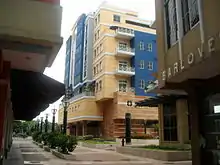

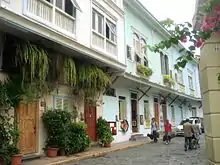
| Guayaquil City Territorial Organization Number of the sector in reference with the City Map | |||||||
| # | Sectors | # | Sectors | # | Sectors | ||
|---|---|---|---|---|---|---|---|
| 1 | 9 de Octubre Este | 25 | Febres Cordero | 49 | Prosperina | ||
| 2 | 9 de Octubre Oeste | 26 | Floresta | 50 | Puerto Azul Norte | ||
| 3 | Abel Gilbert | 27 | La Florida | 51 | Puerto Azul Sur | ||
| 4 | Acuarela | 28 | García Moreno | 52 | Puerto Lisa | ||
| 5 | Los Álamos | 29 | Garzota | 53 | Quinto Guayas Este | ||
| 6 | Alborada Este | 30 | Guangala | 54 | Quinto Guayas Oeste | ||
| 7 | Alborada Oeste | 31 | Guasmo Este | 55 | Río Guayas | ||
| 8 | Los Almendros | 32 | Guasmo Oeste | 56 | Roca | ||
| 9 | Las Américas | 33 | Huancavilca | 57 | Rocafuerte | ||
| 10 | Atarazana | 34 | Isla Trinitaria | 58 | La Saiba | ||
| 11 | Ayacucho | 35 | Kennedy | 59 | Samanes | ||
| 12 | Bastión Popular | 36 | Letamendi | 60 | San Eduardo | ||
| 13 | Batallón del Suburbio | 37 | Luz del Guayas | 61 | Los Sauces | ||
| 14 | Bellavista | 38 | Mapasingue | 62 | Simón Bolívar | ||
| 15 | Bolívar | 39 | Miraflores | 63 | Sopeña | ||
| 16 | Los Ceibos | 40 | Monte Bello | 64 | Sucre | ||
| 17 | Centenario | 41 | Olmedo | 65 | Tarqui | ||
| 18 | Cerro del Carmen | 42 | Las Orquídeas Este | 66 | Unión | ||
| 19 | Cóndor | 43 | Las Orquídeas Oeste | 67 | Urdenor | ||
| 20 | Cuba | 44 | Paraíso | 68 | Urdaneta | ||
| 21 | Del Astillero | 45 | Pascuales | 69 | Urdesa | ||
| 22 | Estero Salado | 46 | Pedro Carbo | 70 | Los Vergeles | ||
| 23 | Los Esteros | 47 | Las Peñas | 71 | Ximena | ||
| 24 | La FAE | 48 | La Pradera | 72 | Mirador Norte | ||
Here you can find the list of Neighborhoods and Parishes of Guayaquil
Demographics
| Historical Populations Guayaquil City Compared with Guayas Province, Canton of Guayaquil, and Guayaquil City[28] | |||
| Census | Guayas Province | Canton of Guayaquil | Guayaquil City |
| 1950 | 582.144 | 331.942 | 258.966 |
| 1962 | 979.223 | 567.895 | 510.804 |
| 1974 | 1,512,333 | 907.013 | 823.219 |
| 1982 | 2.038.454 | 1.328.005 | 1.199.344 |
| 1990 | 2,515,146 | 1,570,396 | 1,508,444 |
| 2001 | 3,309,034 | 2,039,781 | 1,985,379 |
| 2010 | 3,645,483 | 2,350,915 | 2,291,158 |
| Source: Instituto Nacional de Estadisticas y Censos | |||
| Percentage Population Growth of Guayaquil City Compared with Guayas Province, Canton of Guayaquil, and Guayaquil City.[28] | |||
| Census | Guayas Province | Canton of Guayaquil | Guayaquil City |
| 1950–1962 | 4.34% | 4.49% | 5.67% |
| 1962–1974 | 3.77% | 4.06% | 4.14% |
| 1974–1982 | 3.52% | 4.50% | 4.44% |
| 1982–1990 | 2.63% | 2.10% | 2.87% |
| 1990–2001 | 2.49% | 2.38% | 2.50% |
| 2001–2010 | 1.12% | 1.69% | 1.71% |
| Source: Instituto Nacional de Estadisticas y Censos | |||
Food
.jpg.webp)
Typical Guayaquil cuisine includes mostly seafood dishes such as encebollado, ceviche, cazuela, and encocado (shrimp or tuna with a coconut sauce and rice).
During breakfast, patacones and bolon (fried plantain with cheese mashed and given a rounded shape) play a big role. These plantain dishes are often accompanied with bistec de carne or encebollado de pescado.
Another prominent breakfast dish are empanadas "de viento" made with wheat flour and stretchy cheese or empanadas "de verde" plantain based with mozzarella cheese.
Pan de yuca similar to pão de queijo usually served with "yogur persa" is a typical snack in Guayaquil. With the rise in middle eastern migration, shawarma shops dot the city.
Chifa or Chinese-Ecuadorian dishes like arroz chaufa, tallarin saltado, and sopa Fui Chi Fu are common fast food options.
Some other original dishes of Guayaquil are the plantain ball soup (based on peanuts and green plantains creating a green plantain ball filled with meat and other ingredients). Bollo, analogous to hallaca, is another typical dish of this city that also the main ingredient is the green plantain and seafood. Just to mention others are the biche, sango de mariscos, and arroz con pescado frito (rice with fried fish)
Arroz con menestra y carne asada (rice with stew and roast meat), churrasco, Guatita, Caldo de mondongo, Humitas, Maduro lampriado, Maduro con queso, Tripita, are some more dishes included in the great and diverse gastronomy of the city.
Notable people
Arts and literature
- Daniela Alcívar Bellolio (b. 1982, Guayaquil)
- Félix Arauz (b. 1935, Guayaquil)
- Theo Constanté (1934–2014, Guayaquil)
- José de la Cuadra (1903, Guayaquil – d. 1941, Guayaquil)
- Alfredo Pareja Diezcanseco (1908, Guayaquil – d. 1993, Quito)
- Carmen Febres-Cordero de Ballén (b. 1829, Guayaquil – d. 1893, Valparaíso)
- Araceli Gilbert (b. 1913, Guayaquil – d. 1993, Quito)
- Enrique Gil Gilbert (1912, Guayaquil – d. 1973, Guayaquil)
- Julio Jaramillo (b. 1935, Guayaquil – d. 1978, Guayaquil)*
- Joaquín Gallegos Lara (b. 1909, Guayaquil – d. 1947, Guayaquil)
- Numa Pompilio Llona (b. 1832, Guayaquil – d. 1907, Guayaquil)
- Demetrio Aguilera Malta (b. 1909, Guayaquil – d. 1981, Mexico)
- Luis Miranda (b. 1932, Guayaquil)
- Luis Molinari (b. 1929, Guayaquil)
- Elisa Ortiz de Aulestia (b. 1909, Guayaquil – 1991)
- Xavier Blum Pinto (b. 1957, Guayaquil)
- José Martínez Queirolo (b. 1931, Guayaquil – d. 2008, Guayaquil)
- Víctor Manuel Rendón (b. 1859, Guayaquil – d. 1940, Guayaquil)
- Enrique Tábara (b. 1930, Guayaquil)
- Jorge Velarde (b. 1960, Guayaquil)
- Juan Villafuerte (b. 1945, Guayaquil – d. 1977, Barcelona, Spain)
- Eugenia Viteri (b. 1928, Guayaquil)
Others
- Olga Álava, Miss Ecuador Earth 2011, Miss Earth 2011
- Noralma Vera Arrata, ballerina and choreographer
- Frederick Ashton, British choreographer and dancer
- Geovanni Camacho, football player
- María Elisa Camargo, actress
- Danilo Carrera, actor and model
- Fernanda Cornejo, fashion model and Miss International 2011
- Felipe Caicedo, footballer
- María Capovilla, oldest person
- Jorge Delgado, swimmer
- Beatriz Parra Durango, opera singer
- Jenny Estrada, writer
- Jorge Perrone Galarza, politician
- Karina Galvez, poet[29]
- Gerardo, rapper
- Andrés Gómez, tennis player
- Catalina de Jesús Herrera, nun and writer
- Mike Judge, American animator and television writer
- Guillermo Lasso, former President of Ecuador
- Rita Lecumberri, writer
- Demetrio Aguilera Malta, writer
- Roberto Manrique, actor
- Debbie Mucarsel-Powell, American politician
- Francisco Nazareno, footballer
- Adalberto Ortiz, poet
- Albert Paulsen, actor
- Joao Plata, footballer
- Jorge Saade, violinist
- Hugo Savinovich, wrestler
- Pancho Segura, tennis player
- María del Tránsito Sorroza, midwife and formerly enslaved woman
- Jan Topić, businessman
- Benjamin Urrutia, academic
- Pedro Jorge Vera, writer
- Alex Jimbo Viteri, violinist
- Rosa Borja de Ycaza, writer
- Presley Norton Yoder, archeologist
Education
Biblioteca Municipal de Guayaquil (Municipal Library of Guayaquil) serves as the public library of Guayaquil.[30] The city has several universities, including the University of Guayaquil (founded in 1867), the Universidad Catolica de Santiago de Guayaquil, the Escuela Superior Politecnica del Litoral (ESPOL), and the Universidad de Especialidades Espiritu Santo.
Religion
The largest religion in Guayaquil is Christianity.
Sports

There are two major association football clubs; the Barcelona Sporting Club and the Club Sport Emelec. Each club has its own stadium; the Estadio Monumental Banco Pichincha is the home of the "Barcelonistas" while the Estadio George Capwell is the home of the "Emelecistas". These two teams have a long history of rivalry in Guayaquil and when these two teams play against each other the game is called "El Clásico del Astillero".
The city is the birthplace of Francisco Segura Cano; and Andrés Gómez and Nicolás Lapentti, Ecuador's two most successful tennis players, now both retired. The "Abierto de Tenis Ciudad de Guayaquil" is a tennis tournament organised in Guayaquil by Gómez and Luis Morejon, and held annually in November.
Another major event in the city is the Guayaquil Marathon, which has been held every year on the first weekend of October since 2005. These race is certified by the (AIMS) Association of International Marathons and Distance Races.
The sports & Ecological Park called Parque Samanes de Guayaquil is a park with courts for soccer, tennis, volleyball, and basketball, two lakes, a soccer stadium and an amphi theatre for open air concerts and events. It is connected to a forest reserve with trails for cycling and walking, as well as installations for climbing and zip-lining.
Universities

Some of Guayaquil's main universities are:
- Escuela Superior Politécnica del Litoral
- Universidad de Especialidades Espíritu Santo
- University of Guayaquil
- Universidad Católica de Santiago de Guayaquil
- Universidad Laica Vicente Rocafuerte
- Universidad Casa Grande
- Universidad Tecnológica Ecotec
- Universidad Santa María
- Blue Hill College
- Universidad Del Pacífico – Ecuador
- Institute of Graphics Arts and Digital Science
- Universidad Politécnica Salesiana
Transport
Guayaquil is located along national Highway 40 and is near Highway 25.
Among Guayaquil's major trading points are the seaport, the largest in Ecuador and one of the biggest handlers of shipping on the shores of the Pacific; and José Joaquín de Olmedo International Airport.
José Joaquín de Olmedo International Airport, though using the same runways, had its passenger terminal completely rebuilt in 2006 and was renamed. The old passenger terminal is now a convention centre.[31]
Guayaquil is served by a bus rapid transit system, Metrovia, which opened in 2006. The system has three lines and is supplemented by 35 feeder routes, carrying a total of 400,000 daily passengers.[32]
The Empresa de Ferrocarriles Ecuatorianos offers tourist rail service to Quito from the neighboring city of Durán, Ecuador, located across the Guayas River from Guayaquil.[33]
Port of Guayaquil
The Port of Guayaquil is the most important one in Ecuador and one of the major ports in Latin America. The port provides capacities for handling cargo, but is also a hub for transshipment for other countries in the pacific region.[34]
Since the decrease of the Colombian FARC drug gang business and the raise of Ecudorian kartells, the harbour of Guayaquil is one of the most important spots of drug trafficing to Columbia, Mexico and the US.[35][36]
Responsibel for port operation is the state Guayaquil Port Authority.[34]
Twin towns – sister cities
Guayaquil is twinned with:
See also
- Casa del Hombre Doliente – care facility for those suffering a terminal illness
- Newspapers of Guayaquil
- Aerovia (Guayaquil)
References
- ↑ "Citypopulation.de Population and area of Guayaquil." Instituto Nacional de Estadísticas y Censos. Retrieved on December 31, 2023.
- ↑ "TelluBase—Ecuador Fact Sheet (Tellusant Public Service Series)" (PDF). Tellusant. Retrieved January 11, 2024.
- ↑ Avilés Pino; Hoyos Galarza, Historia de Guayaquil, p. 11.
- ↑ Correa Bustamante, p. 120.
- 1 2 Rodolfo Pérez Pimentel (ed.). "Guayaquile". Diccionario Biográfico Ecuador. Archived from the original on March 4, 2016. Retrieved October 27, 2009.
- ↑ "El nombre de Guayaquil". Fundación Malecón 2000. Archived from the original on February 8, 2004. Retrieved October 27, 2009.
- ↑ Guamán Poma (1615). Guaman Poma, Nueva corónica y buen gobierno (1615). p. 1023 – via Royal Library, Denmark website.
- ↑ 25 July is an official holiday in Guayaquil. Historians have not yet reached a consensus about the date of Guayaquil's foundation or founder. The city might have been founded more than once. Another possible founder might be Diego de Almagro.
- ↑ 25 July 1538, OnThisDay.com. Accessed 6 August 2023.
- ↑ "Intercolonial Friction (1660—1700)", in Wars of the Americas: A Chronology of Armed Conflict in the Western Hemisphere (ABC-CLIO, 2008) p. 308
- ↑ Guarda, Gabriel (1973). La economía de Chile Austral antes de la colonización alemana. Valdivia: Universidad Austral de Chile. pp. 45–47.
- ↑ León Sáenz, Jorge (2009), "Los astilleros y la industria marítima en el Pacífico americano: Siglos XVI a XIX", Diálogos, Revista Electrónica de Historia, 10 (1): 44–90
- ↑ Schottenhammer, Angela (2019), "Connecting China with the Pacific World?", Orientierungen: Zeitschrift zur Kultur Asiens, 31: 111–170, p. 144
- ↑ "Sacramento Daily Union 28 November 1896 — California Digital Newspaper Collection".
- ↑ "Ecuador coronavirus: Bodies are being left in the streets in an overwhelmed city". msn.com. Retrieved April 5, 2020.
- ↑ "Coronavirus nightmare in Ecuador's main city Guayaquil – pictures". BBC. April 17, 2020.
- ↑ "Guayaquil y como el mercado siempre aparece: El retorno de los 'informales'", Diario Expreso. Accessed 6 August 2023.
- ↑ Carvajal, Ana María (10 de enero de 2019). «Quito se convirtió en la ciudad más poblada del Ecuador con más de 3 millones de habitantes en el 2018». El Comercio. Consultado el 11 de enero de 2019.
- ↑ Pheiffer, Evan (November 12, 2018). "E-Ecuador". The Business Year. Retrieved February 4, 2020.
- ↑ «Quito es ahora la ciudad más poblada de Ecuador». El Telégrafo. 12 de enero de 2019. Archivado desde el original el 27 de marzo de 2019. Consultado el 12 de enero de 2019.
- ↑ Ioualalen, M.; Monfret, T.; Béthoux, N.; Chlieh, M.; Adams, G. Ponce; Collot, J.-Y.; Bustamante, C. Martillo; Chunga, K.; Navarrete, E. (May 9, 2014). "Tsunami mapping in the Gulf of Guayaquil, Ecuador, due to local seismicity". Marine Geophysical Research. 35 (4): 361–378. Bibcode:2014MarGR..35..361I. doi:10.1007/s11001-014-9225-9. ISSN 0025-3235. S2CID 128481376.
- ↑ Vera-Grunauer, X.; J.D., Bray; Pestana, J.M.; Kayen, R.; Tandazo, E.; Ramire, J.; Vera-Grunauer, J.G.; Mera-Ortiz, W. (2006). "Site Characterization and Seismic Zonation of Guayaquil City, Ecuador" (PDF). 8th US National Conference on Earthquake Engineering 2006, v 16, p 9672-9681. Retrieved November 13, 2016.
- ↑ Witt, César; Bourgois, Jacques; Michaud, François; Ordoñez, Martha; Jiménez, Nelson; Sosson, Marc (June 1, 2006). "Development of the Gulf of Guayaquil (Ecuador) during the Quaternary as an effect of the North Andean block tectonic escape". Tectonics. 25 (3): TC3017. Bibcode:2006Tecto..25.3017W. doi:10.1029/2004TC001723. ISSN 1944-9194. S2CID 134409407.
- ↑ Witt, César; Bourgois, Jacques (January 1, 2010). "Forearc basin formation in the tectonic wake of a collision-driven, coastwise migrating crustal block: The example of the North Andean block and the extensional Gulf of Guayaquil-Tumbes Basin (Ecuador-Peru border area)". Geological Society of America Bulletin. 122 (1–2): 89–108. Bibcode:2010GSAB..122...89W. doi:10.1130/B26386.1. ISSN 0016-7606.
- ↑ "World Weather Information Service – Guayaquil". Met Office. Retrieved January 16, 2016.
- ↑ "WMO Normals – Guayaquil". NOAA. Retrieved January 16, 2016.
- 1 2 Evolución de la población de la provincia, Cantón Guayaquil, y de la Ciudad de Guayaquil – Guayas, Censo 2001, Según el Instituto Nacional de Estadisticas y Censos
- ↑ "ÉSE, SU GUAYAQUIL VIEJO" (PDF). Karinagalvez.com. Archived from the original (PDF) on July 13, 2011. Retrieved July 8, 2017.
- ↑ "Inicio Archived March 29, 2009, at the Wayback Machine." Biblioteca Municipal de Guayaquil. Retrieved on April 7, 2009.
- ↑ "Centro de Convenciones de Guayaquil :: Ubicación". Archived from the original on January 7, 2011. Retrieved April 1, 2011.
- ↑ "Metrovía pone en celulares datos sobre rutas y paradas" [Metrovía puts route and stop information on cell phones]. El Universo. March 16, 2017. Retrieved December 27, 2017.
- ↑ "Quito – Guayaquil Train Route | Andes through Coast on the Tren Crucero". www.ecuadorrail.net. Retrieved April 15, 2022.
- 1 2 Lipner, Jennifer (April 1, 2023). "The Guayaquil Port Authority". AAPA Seaports. Retrieved January 14, 2024.
- ↑ "Hidden in bananas and tea, cocaine departs Ecuador port by the ton". France 24. April 21, 2022. Retrieved January 12, 2024.
- ↑ "Soldiers patrol streets in Ecuador as government and cartels declare war on each other - CBS News". www.cbsnews.com. January 10, 2024. Retrieved January 12, 2024.
- ↑ "Sister Cities". houstontx.gov. City of Houston. Retrieved December 21, 2021.
- ↑ "市级友好城市". sh.gov.cn (in Chinese). Shanghai. Retrieved December 21, 2021.
External links
 Guayaquil travel guide from Wikivoyage
Guayaquil travel guide from Wikivoyage- Images of Guayaquil before and After
- Municipalidad de Guayaquil
